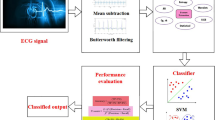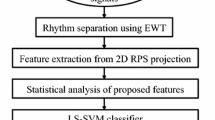Abstract
Purpose
To evaluate discrete wavelet transform coefficients and identify descriptors of pattern electroretinogram (PERG) waveforms in order to determine PERG characteristics for optimizing the diagnosis of early primary open-angle glaucoma (POAG).
Methods
Pattern electroretinogram was performed in 30 normal eyes and 30 eyes with primary open-angle glaucoma according to the ISCEV protocol. The check size was 0.8° and 16°, and the color was black/white in both groups. The results were analyzed in time domain (TD) and discrete wavelet transform (DWT) using the MATLAB software. The mean value, standard deviation, and relative energy of level 6 and 7 detail coefficients (d6, d7) and level 7 approximation coefficients (a7) of Daubechies 4 (db4), Daubechies 8 (db8), Symlet 5 (sym5), Symlet 7 (sym7), and Coiflet 5 (coif5) wavelets were calculated. In all the mentioned wavelets, DWT descriptors were extracted. Signals were reconstructed by inverse DWT. All data obtained by TD and DWT analyses were compared between the two groups.
Results
In both check sizes, a significant attenuation of N95 amplitude was seen in the patient group. The relative energy of a7 of db8 increased significantly in the POAG group in the 0.8° check size. In larger check stimuli, the relative energy of d7 of coif5 decreased significantly and the standard deviation of d7 of sym7 increased markedly in glaucomatous patients (P < 0.05). In small stimuli, N95 descriptor (7N) of db8 had the highest value and showed a significant increase as compared to the POAG group. In the 16° check size, there was no significant difference. A strong correlation was seen between reconstructed signals and originals (r = 0.99).
Conclusion
The DWT can quantify PERG responses more accurately. In agreement with TD and wavelet coefficients domain results, 7N of db8 decomposition can be used as a good indicator for early detection of POAG.



Similar content being viewed by others
References
Schon K, Wollstein G, Schuman JS, Sung KR (2014) Prediction of glaucomatous field progression: pointwise analysis. Curr Eye Res 39:705–710
Johnson EC, Morrison JC (2009) Friend or foe? Resolving the impact of glial response in glaucoma. J Glaucoma 18(5):341–353. https://doi.org/10.1097/IJG.0b013e31818c6ef6
Weinreb RN, Khaw PT (2004) Primary open-angle glaucoma. Lancet 363(9422):1711–1720. https://doi.org/10.1016/S0140-6736(04)16257-0
Kapetanakis VV, Chan MP, Foster PJ, Cook DG, Owen CG, Rudnicka AR (2015) Global variations and time trends in the prevalence of primary open angle glaucoma (POAG): a systematic review and meta-analysis. Br J Ophthalmol 100(1):86–93. https://doi.org/10.1136/bjophthalmol-2015-307223
Bettin P, Di Matteo F (2013) Glaucoma: present challenges and future trends. Ophthalmic Res 50:197–208
Weinreb RN, Aung T, Medeiros FA (2014) The pathophysiology and treatment of glaucoma: a review. JAMA 311(18):1901–1911. https://doi.org/10.1001/jama.2014.3192
Kreuz AC, Oyamada MK, Hatanaka M, Monteiro MLR (2014) The role of pattern-reversal electroretinography in the diagnosis of glaucoma. Arq Bras Oftalmol 77(6):403–410. https://doi.org/10.5935/0004-2749.20140101
Omoti AE, Okeigbemen VW, Waziri-Erameh JM (2009) Current concepts in the diagnosis of primary open angle glaucoma. West Afr J Med 28(3):141–147
Takagi D, Sawada A, Yamamoto T (2017) Evaluation of a new rebound self-tonometer, Icare homa: comparison with Goldman applanation tonometer. J Glaucoma 26(7):613–618. https://doi.org/10.1097/IJG.0000000000000674
Bussel II, Wollstein G, Schuman JS (2014) OCT for glaucoma diagnosis, screening and detection of glaucoma progression. Br J Ophthalmol 98(Suppl 2):ii15–ii19. https://doi.org/10.1136/bjophthalmol-2013-304326
Popescu DP, Choo-Smith LP, Flueraru C, Mao Y, Chang S, Disano J, Sherif S, Sowa MG (2011) Optical coherence tomography: functional principles, instrumental designs and biomedical applications. Biophys Rev 3(3):155–169. https://doi.org/10.1007/s12551-011-0054-7
Podoleanu AG (2012) Optical coherence tomography. J Microsc 247(3):209–219. https://doi.org/10.1111/j.1365-2818.2012.03619.x
Bach M, Hoffmann MB (2008) Update on the pattern electroretinogram in glaucoma. Optom Vis Sci 85(6):386–395. https://doi.org/10.1097/OPX.0b013e318177ebf3
Wu Z, Medeiros FA (2018) Recent development in visual field testing for glaucoma. Curr Opin Ophthalmol 29(2):141–146. https://doi.org/10.1097/ICU.0000000000000461
Leonard KC, Hutnik CML (2010) Using electroretinography for glaucoma diagnosis. In: Schacknow PN, Samples JR (eds) The glaucoma book: a practical, evidence-based approach to patient care, 1st edn. Springer, Berlin, pp 265–267
Parisi V, Miglior S, Manni G, Centofanti M, Bucci MG (2006) Clinical ability of pattern electroretinograms and visual evoked potentials in detecting visual dysfunction in ocular hypertension and glaucoma. Ophthalmology 113:216–228. https://doi.org/10.1016/j.ophtha.2005.10.044
Parisi V, Manni G, Centofanti M, Gandofi SA, Ozli D, Bucci M (2001) Correlation between optical coherence tomography, pattern electroretinogram, and visual evoked potentials in open-angle glaucoma patients. Ophthalmology 108:905–912
Luo X, Frishman LJ (2011) Retinal pathway origins of the pattern electroretinogram (PERG). Investig Ophthalmol Vis Sci 52(12):8571–8584. https://doi.org/10.1167/iovs.11-8376
Fisher AC, Hagan RP, Brown MC (2007) Automatic positioning of cursors in the transient pattern electroretinogram (PERG) with very poor SNR using an expert system. Doc Ophthalmol 115:61–68
Bach M, Brigell MG, Holder GE, Meigen T, Hawlina M, Johnson MA, Viswanathan S, McCulloch DL (2013) ISCEV standard for clinical pattern electroretinography (PERG): 2012 update. Doc Ophthalmol 126:1–7
Berninger TA, Arden GB (1988) The pattern electroretinogram. Eye (Lond) 2(Suppl):S257–S283. https://doi.org/10.1038/eye.1988.149
Porciatti V (2015) Electrophysiological assessment of retinal ganglion cell function. Exp Eye Res 141:164–170. https://doi.org/10.1016/j.exer.2015.05.008
Hood DC, Xu L, Thienprasiddhi P, Greenstein VC, Odel JG, Grippo TM, Liebmann JM, Ritch R (2005) The pattern electroretinogram in glaucoma patients with confirmed visual field deficits. Investig Ophthalmol Vis Sci 46:2411–2418. https://doi.org/10.1167/iovs.05.0238
Rafiee J, Rafiee MA, Prause N, Schoen MP (2011) Wavelet basis functions in biomedical signal processing. Expert Syst Appl 38(5):6190–6201. https://doi.org/10.1016/j.eswa.2010.11.050
Akay M (1998) Time frequency and wavelets in biomedical signal processing. IEEE Press series in Biomedical Engineering, First edn. Wiley, New York, pp 230–257
Penkala K (2010) Continuous wavelet transformation of pattern electroretinogram (PERG)-a tool improving the test accuracy. In: Bamidis P, Pallikarakis N (eds) XII Mediterranean conference on medical and biological engineering and computing 2010. Springer, Berlin, pp 196–199
Rogala T, Brykalski A (2005) Wavelet feature space in computer-aided electroretinogram evaluation. Pattern Anal Appl 8:238–246. https://doi.org/10.1007/s10044-005-0003-9
Gauvin M, Lina JM, Lachapelle P (2014) Advance in ERG analysis: from peak time and amplitude to frequency, power, and energy. Biomed Res Int. https://doi.org/10.1155/2014/246096
Gauvin M, Little JM, Lina JM, Lachapelle P (2015) Functional decomposition of the human ERG based on the discrete wavelet transform. J Vis 15(16):1–22
Gauvin M, Chakor H, Koenekoop RK, Little JM, Lina JM, Lachapelle P (2016) Witnessing the first sign of retinitis pigmentosa onset in the allegedly normal eye of a case of unilateral RP: a 30-year follow-up. Doc Ophthalmol 132:213–229. https://doi.org/10.1007/s10633-016-9537-y
Varadharajan S, Fitzgerald K, Lakshminarayanan V (2000) Wavelet analysis of ERG of patients with Duchenne Muscular Dystrophy. In: Vision science and its application, OSA Technical Digest, pp 65–68
Miguel Jimenez JM, Blanco R, Boquete L, Rodriguez Ascariz JM, De la Villa Polo P (2008) Multifocal electroretinography. Glaucoma diagnosis by means of the wavelet transform. In: Electrical and computer engineering, CCEC, Canadian conference, pp 867–870
Varadharajan S, Fitzgerald K, Lakshminarayanan V (2007) A novel method for separating the components of the clinical electroretinogram. J Mod Opt 54(9):1263–1280
Miguel-Jimenez JM, Boquete L, Ortega S, Rodriguez-Ascariz JM, Blanco R (2010) Glaucoma detection by wavelet-based analysis of the global flash multifocal electroretinogram. Med Eng Phys 32:617–622
Miguel-Jimenez JM, Ortega S, Boquete L, Rodriguez-Ascariz JM, Blanco R (2011) Multifocal ERG wavelet packet decomposition applied to glaucoma diagnosis. BioMed Eng Online 10:37. https://doi.org/10.1186/1475-925X-10-37
Nair SS, Joseph P (2014) Wavelet based electroretinographic signal analysis for diagnosis. Biomed Signal Process Control 9(1):37–44. https://doi.org/10.1016/j.bspc.2013.09.008
Gauvin M, Suster M, Little JM, Brecelj J, Lina JM, Lachapelle P (2017) Quantifying the on and off contributions to the flash ERG with the discrete wavelet transform. Trans Vis Sci Technol 6(1):3. https://doi.org/10.1167/tvst.6.1.3
Mallat SG (2009) A wavelet tour of signal processing the sparse way, 3rd edn. Academic Press, Houston
Addison PS (2002) The illustrated wavelet transform handbook: introductory theory and applications in science, engineering, medicine and finance. CRC Press, Boca Raton. https://doi.org/10.1201/9781420033397.fmatt
Bode SF, Jehle T, Bach M (2011) Pattern electroretinogram (PERG) in glaucoma suspects-new findings from a longitudinal study. Investig Ophthalmol Vis Sci 52:4300–4306. https://doi.org/10.1167/iovs.10-6381
Graham SL, Drance SM, Chauhan BC, Swindale NV, Hnik P, Mikelberg FS, Douglas GR (1996) Comparison of psychophysical and electrophysiological testing in early glaucoma. Investig Ophthalmol Vis Sci 37:2651–2662
Jafarzadehpour E, Radinmehr F, Pakravan M, Mirzajani A, Yazdani SH (2013) Pattern electroretinography in glaucoma suspects and early primary open angle glaucoma. J Ophthalmic Vis Res 8(3):199–206
Demir ST, Oba ME, Erdogan ET, Odabasi M, Dirim AB, Demir M, Can E, Kara O, Sendül (2015) Comparison of pattern electroretinography and optical coherence tomography parameters in patients with primary open-angle glaucoma and ocular hypertension. Turk J Ophthalmol 45:229–234
Ventura LM, Sorokac N, Santos RDL, Feuer WJ, Porciatti V (2006) The relationship between retinal ganglion cell function and retinal nerve fiber thickness in early glaucoma. Investig Ophthalmol Vis Sci 47(9):3904–39011
Ganekal S, Dorairaj S, Jhanji V (2013) Pattern electroretinography changes in patients with established or suspected primary open angle glaucoma. J Curr Glaucoma Pract 7(2):39–42. https://doi.org/10.5005/jp-journal-10008-1135
Sunga RN, Enoch JM (1970) A static perimetric technique believed to test receptive field properties. 3. Clinical trials. Am J Ophthalmol 70:244–272
Junoy Montolio FG, Meems W, Janssens MSA, Stam L, Jansonius NM (2016) Lateral inhibition in the human visual system in patients with glaucoma and healthy subjects: a case control study. PLoS ONE 11(3):e0151006. https://doi.org/10.1371/journal.pone.0151006
Mueller BH, Stankowska DL, Krishnamoorthy PR (2011) Neuroprotection in glaucoma. In: RumeltSh (ed) Glaucoma—basic and clinical concepts. INTECH Open Access Publisher
Cheung W, Guo L, Cordeiro MF (2008) Neuroprotection in glaucoma: drug-based approaches. Optom Vis Sci 85(6):406–416. https://doi.org/10.1097/OPX.0b013e31817841e5
Van der Tweel LH, Estévez O (2006) Analytical techniques. In: Heckenlively JR, Arden GB (eds) Principles and practice of clinical electrophysiology of vision, 2nd edn. MIT Press, Cambridge, pp 439–459
Bach M, Speidel-Fiaux A (1989) Pattern electroretinogram in glaucoma and ocular hypertension. Doc Ophthalmol 73(2):173–181. https://doi.org/10.1007/BF00155035
Author information
Authors and Affiliations
Corresponding author
Ethics declarations
Conflict of interest
All authors certify that there is no actual or potential conflict of interest in relation to this article.
Ethical approval
All procedures performed in studies involving human participants were in accordance with the ethical standards of the institutional and/or national research committee and with the 1964 Declaration of Helsinki and its later amendments or comparable ethical standards.
Informed consent
Informed consent was obtained from all individual participants included in the study.
Additional information
Publisher's Note
Springer Nature remains neutral with regard to jurisdictional claims in published maps and institutional affiliations.
Rights and permissions
About this article
Cite this article
Hassankarimi, H., Noori, S.M.R., Jafarzadehpour, E. et al. Analysis of pattern electroretinogram signals of early primary open-angle glaucoma in discrete wavelet transform coefficients domain. Int Ophthalmol 39, 2373–2383 (2019). https://doi.org/10.1007/s10792-019-01077-w
Received:
Accepted:
Published:
Issue Date:
DOI: https://doi.org/10.1007/s10792-019-01077-w




